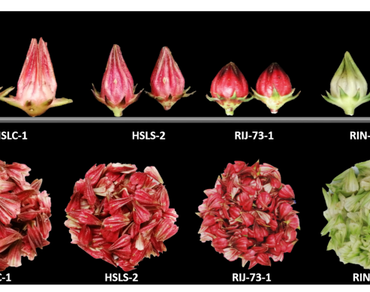Agro-morphological and nutritional profiling of different roselle (H. sabdariffa var. sabdariffa) morphotypes
Research Articles | Published: 30 March, 2023
First Page: 397
Last Page: 403
Views: 3203
Keywords: Agro-morphological trait, n Hibiscus sabdariffan , Morphotypes, Nutritional composition, Roselle
Abstract
Four different roselle (H. sabdariffa var. sabdariffa) morphotypes were evaluated for agro-morphological and nutritional characteristics. Clear plant architectural differences were observed among the morphotypes. Genotype RIJ-73-1 was characterised as tall, shy branching type with low calyx yield, while other genotypes (HSLC-1, HSLC-2 and RIN-257-1) were short bushy type with profuse branching habit. HSCL-1 bears long, thick and fleshy calyx, it is the highest calyx yielder followed by HSLC-2 (140.0 ± 14.0 g/plant) and RIN-257-1 (87.8 ± 7.2 g/plant). Nutrient analysis indicated that roselle calyces are rich in minerals like K, Ca, Mg, Na, Fe and vitamins like C, B1, B3, B5. Roselle as a high-value nutritive vegetable supplies significant amount of recommended daily allowance of mineral and vitamins of an adult. The genotypes HSLC-1 and HSLC-2 recorded highest concentration of minerals. While, RJI-73-1 recorded high concentration of Fe and vitamins like A, B2, B3, B5 and C in the calyces.

References
Alarcon-Alonso J, Zamilpa A, Aguilar FA, Herrera-Ruiz M, Tortoriello J, Jimenez-Ferrer E (2012) Pharmacological characterization of the diuretic effect of Hibiscus sabdariffa Linn (Malvaceae) extract. J Ethnopharmacol 139(3):751–756
Amin I, Hainida EKI, Halimatul SMN (2008) Roselle (Hibiscus sabdariffa L.) seeds- National composition, protein quality and health benefits. Foods 2(1):1–16
Anhwange BA, Ajibola VO, Okibe FG (2006) Nutritive value and anti-nutritional factors in Hibiscus sabdariffa. J Fish Int 1(2–4):73–76
Atta S, Benoit S, Aissa BD, Yacoubou B, Issaka L, Mahamane S (2013) Nutrients composition of calyces and seeds of three Roselle (Hibiscus sabdariffa L.) ecotypes from Niger. Afr J Biotechnol 12(26):4174–4178
Babalola SO, Babalola AO, Aworh OC (2001) Compositional attributes of the calyces of roselle (Hibiscus sabdariffa L.). Innovative institutional communications. J Food Technol Afr 6:133–134
Chang YC, Huang KX, Huang AC, Ho YC, Wang CJ (2006) Hibiscus anthocyanins-rich extract inhibited LDL oxidation and oxLDL-mediated macrophages apoptosis. Food Chem Toxicol 44(7):1015–1023
Chokevivat V, Chuthaputti A, Khumtrakul P (2005) The use of traditional medicine in the Thai health care system. Regional Consultation on Development of Traditional Medicine in the South East Asia Region: 1–13
Cisse M, Dornier M, Sakho M, Ndiaye A, Reynes M, Sock O (2009) Le bissap (Hibiscus sabdariffa L.): composition et principales utilisations. Fruits 64(3):179–193
Egharevba RKA, Law-Ogbomo KE (2007) Comparative effects of two nitrogen sources on the growth and the yield of Roselle (Hibiscus sabdariffa) in rainforest region: a case study of Benin-city, Edo state. Nig J Agron 6:142–146
El-Shiekh RA, Ashour RM, Abd El-Haleim EA, Ahmed KA, Abdel-Sattar EA (2020) Hibiscus sabdariffa L.: a potent natural neuroprotective agent for the prevention of streptozotocin-induced Alzheimer’s disease in mice. Biomed Pharmacother 128:110303. https://doi.org/10.1016/j.biopha.2020.110303
Gomez-Aldapa CA, Rangel-Vargas E, Torres-Vitela MR, Villarruel-López A, Acevedo-Sandoval OA, Gordillo-Martínez AJ, Godínez-Oviedo A, Castro-Rosas J (2018) Antibacterial activities of Hibiscus sabdariffa extracts and Chemical Sanitizers directly on Green Leaves contaminated with foodborne pathogens. J Food Prot 81(2):209–217. https://doi.org/10.4315/0362-028X.JFP-17-053
Hirunpanich V, Utaipat A, Morales NP, Bunyapraphatsara N, Sato H, Herunsalee A, Suthisisang C (2005) Antioxidant effects of aqueous extracts from dried calyx of Hibiscus sabdariffa Linn. (Roselle) in vitro using rat low-density lipoprotein (LDL). Biol Pharm Bull 28(3):481–484. https://doi.org/10.1248/bpb.28.481
Hirunpanich V, Utaipat A, Morales NP, Bunyapraphatsara N, Sato H, Herunsale A, Suthisisang C (2006) Hypocholesterolemic and antioxidant effects of aqueous extracts form the dried calyx of Hibiscus sabdariffa L. in hypercholesterolemic rats. J EthnoPharmacol 103:252–260
Mahadevan N, Shivali, Kamboj P (2009) Hibiscus sabdariffa Linn-An overview. Nat Prod Rad 8(1):77–83
Mat Isa A, Isa PM, Abd Aziz AR (1985) Analisis kimia dan pemprosesan roselle (Hibiscus sabdariffa). Mardi Res Bull 13:68–74
Mishra MK, Wang J, Mirzaei R, Chan R, Melo H, Zhang P, Ling CC, Bruccoleri A, Tang L, Yong VW (2022) A distinct Hibiscus sabdariffa extract prevents iron neurotoxicity, a driver of multiple sclerosis pathology. Cells 11(3):440. https://doi.org/10.3390/cells11030440
Morton J (1987) Roselle. In: Julia F, Morton JF (eds) Fruits of warm climates. Web Publications Purdue University, Miami, FL, pp 281–286
Mostofa MG, Islam MR, Morshed Alam ATM, Mahbub SM, Molla MAF (2002) Genetic variability, heritability and correlation studies in kenaf. Online J Biol Sci 2:422–424
Najafpour Boushehri S, Karimbeiki R, Ghasempour S, Ghalishourani SS, Pourmasoumi M, Hadi A, Mbabazi M, Pour ZK, Assarroudi M, Mahmoodi M, Khosravi A, Mansour-Ghanaei F, Joukar F (2020) The efficacy of sour tea (Hibiscus sabdariffa L.) on selected cardiovascular disease risk factors: a systematic review and meta-analysis of randomized clinical trials. Phytother Res 34(2):329–339. https://doi.org/10.1002/ptr.6541
National Agricultural Library, Vitamins, Minerals https://www.nal.usda.gov/fnic/vitamins-and-minerals. (accessed 01 August 2021).
National Institutes of Health. Nutrient recommendations: Dietary Reference Intakes. https://ods.od.nih.gov/HealthInformation/Dietary_Reference_Intakes.aspx. (accessed 01 August 2021).
Nguyen C, Baskaran K, Pupulin A et al (2019) Hibiscus flower extract selectively induces apoptosis in breast cancer cells and positively interacts with common chemotherapeutics. BMC Complement Altern Med 19:98. https://doi.org/10.1186/s12906-019-2505-9
Rao PU (1996) Nutrient composition and biological evaluation of mesta (Hibiscus sabdariffa) seeds. Plant Foods Hum Nutr 49:27–34
Reinhardt D, Kuhlemeier C (2002) Plant architecture. EMBO Rep 3(9):846–851. https://doi.org/10.1093/embo-reports/kvf177
Salami SO, Afolayan AJ (2021) Evaluation of nutritional and elemental compositions of green and red cultivars of roselle: Hibiscus sabdariffa L. Sci Rep 11:1030. https://doi.org/10.1038/s41598-020-80433-8
Shaheen MA, El-Nakhlawy FS, Al-Shareef AR (2012) Roselle (Hibiscus sabdariffa L.) seeds as unconventional nutritional source. Afr J Biotechnol 11(41):9821–9824
STAR version 2.0.1 (2014) Biometrics and breeding Informatics. PBGB Division, International Rice Research Institute, Los Baños, Laguna
Sukkhaeng S, Promdang S, Doung-ngern U (2018) Fruit characters and physico-chemical properties of roselle (Hibiscus sabdariffa L.) in Thailand-A screening of 13 new genotypes. J Appl Res Med Aromat Plants 11:47–53
Tounkara F, Amadou I, Le GW, Shi YH (2011) Effect of boiling on the physicochemical properties of roselle seeds (Hibiscus sabdariffa L.) cultivated in Mali. Afr J Biotechnol 10(79):18160–18166
U.S. Food and Drug Administration. Daily value on the new nutrition and supplement facts labels. https://www.fda.gov/food/new-nutrition-facts-label/daily-value-new-nutrition-and-supplement-facts-labels. (accessed 01 August 2021)
Author Information
Crop Improvement Division, ICAR-Central Research Institute for Jute and Allied Fibres, Barrackpore, Kolkata, India